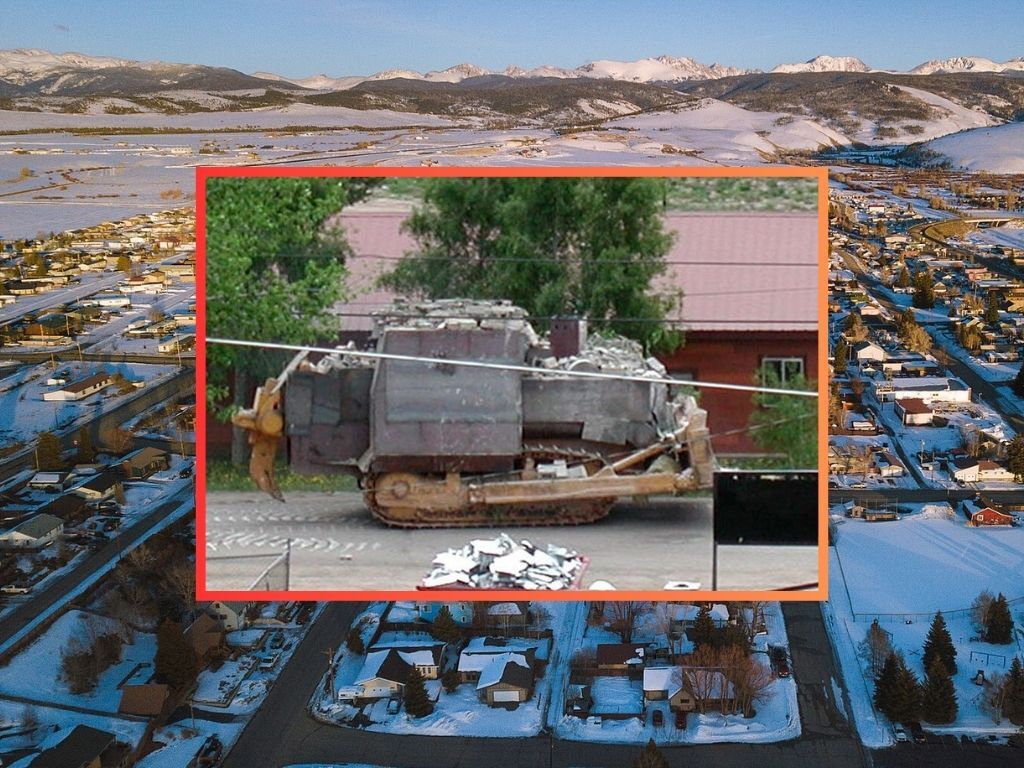LOOKING BACK: The ‘Killdozer’ rampage that caused $7 million of damage in a Colorado mountain town

In 2004, a man did major damage in the 1,749-resident Colorado town of Granby while operating a homemade armored bulldozer capable of withstanding explosions and gunfire. Here’s a look at what happened, why it happened, and where the story stands today.
What Happened
Before we take a look at the day the destruction went down, it’s important to consider a few events leading up to June 4th, 2004.
Marvin Heemeyer had been living in Grand Lake, Colorado for more than 10 years, owning an auto repair shop in nearby Granby. During this time, Heemeyer was involved in an ongoing zoning battle with the town – something that eventually became a factor in his attack.
To set the scene, Granby is the definition of “small-town” Colorado. While population hovers around just 2,300 full-time residents (about 1,750 residents in 2004), the area is a popular hub for outdoor recreation tourism year round. Located in Grand County, Granby is filled with rolling hills of green and is very close to Grand Lake, which is home to the western entrance to Rocky Mountain National Park, as well as Colorado’s largest natural body of water.
The slogan for the Granby is “The Heart of Something Grand,” which is fitting, as the town can serve as a centralized jumping point for everything awesome in Grand County, from Winter Park Ski Resort to destinations like Devil’s Thumb Ranch.
Granted, some have also claimed that ‘small town politics’ have been present in the past, with this sometimes blamed as a factor in Heemeyer’s frustration due to an ongoing zoning battle with the town.
A fight between Heemeyer and the town had been lasting for years prior to his assault, with this conflict reaching a boiling point in 2001, when Heemeyer purchased a bulldozer for what’s still believed to be legitimate construction purposes meant to help solve his ongoing zoning issues. This resulted in another disagreement with the city, after which he converted his bulldozer into a killing machine – eventually dubbed the “Killdozer” by media.
For the next two years, Heemeyer spent time modifying his bulldozer in attempt to make it as impenetrable as possible. He installed armor plating on the sides – most of which was a foot or more thick and filled with a concrete mix for additional strength. It would go on to withstand a reported three explosive blasts and more than 200 rounds of ammunition, according to NBC News.
The armor wasn’t the only modification Heemeyer made. He also installed cameras protected by ballistic plastic that would allow whoever was inside the bulldozer to monitor their surroundings without adding gaps to the protective shield itself. Gun ports were also added to the bulldozer, allowing someone inside the bulldozer to shoot out of it without losing much of their guard.
These events leading up to that fateful June day show that Heemeyer’s attack was the result of a plan that was years in the making.
By the time June 4th, 2004 rolled around, Heemeyer was as ready as he would ever be to execute his assault on the Town of Granby.
Seemingly with the goal of causing as much destruction as possible, Heemeyer started his assault by bursting through the walls of his muffler shop, unveiling his deadly creation to the world. This muffler shop was where he is believed to have modified the machine.
From there, Heemeyer moved on to plow into a concrete business that he blamed for his zoning pain. He rammed the building again and again until the roof collapsed.
It’s around this point when the first gunfire coming from inside the tank was reported. Officers on the scene returned fire, but found their bullets did nothing to slow the mechanical beast.
Heemeyer was, however, quick to notice the return fire. At this point, he used the bulldozer to charge law enforcement on the scene. He began to destroy barriers and police vehicles that surrounded him.
One man, undersheriff Glen Trainor, was bold enough to clamor onto the machine as Heemeyer turned onto the main street of the town.
Still on the bulldozer, Trainor tried to do what he could to slow the vehicle down. He fired close-range shots at potential weak spots in the armor and dropped a flash-bang grenade into the tank’s exhaust pipe. Nothing he did was working and Trainor was forced to leap off the makeshift tank after realizing his efforts were futile.
Unphased by the brazen attempt, Heemeyer plowed into the Granby Town Hall, ripping away much of the outer facade. He continued on to damage the building of an electric company where two former town board members were said to have been employed. He damaged a local construction company’s building by pushing one of their vehicles through their building’s walls. Heemeyer then returned to the town hall to do more damage before targeting the local bank.
Then, at that point, Heemeyer set his eyes on another building that represented a facet of the town that he despised – the local newspaper, Sky-Hi News, a media source he didn’t always agree with. According to this news source, which still operates today, a collision with their securely bolted printing press stopped his vehicle in its tracks. He quickly moved on to other targets.
He damaged two other buildings – an energy company and the home belonging to a widow of a man that he felt wronged him. Keep in mind that this home was inhabited by several people at the time it was destroyed.
At this point, Heemeyer decided it was time to take his destruction to another level. He parked his bulldozer and began taking shots with a .50-caliber rifle presumably at propane tanks and electric equipment, likely hoping to ignite an explosion. He was unsuccessful, likely unable to align a shot given the limited visibility from inside the dozer.
Presumably angered by his failure, Heemeyer headed back toward the town to cause more destruction with his creation. He targeted a store called Gambles that was owned by a former Granby Town Board member.
This turned out to be the wrong call for Heemeyer. Upon plowing deep into the store, his vehicle became disabled. It’s unclear if this was due to overheating or due to the vehicle getting stuck. Various sources seem to leave this detail up to debate. It could have been that the bulldozer got stuck and overheated as a result, but this is still discussed today
Regardless of what stopped the vehicle, the true end of the rampage came with a shot that rang out from its innards. That shot was heard when Marvin Heemeyer made the decision to end his own life.
Marvin’s fate wasn’t revealed for sometime after the attack as authorities still faced the issue of getting inside of the seemingly impenetrable machine – it took up to 12 hours, according to some sources. Aside from the difficulties that the modifications posed, there was also a fear that boobytraps may be present. Eventually, Heemeyer’s body was recovered at 2AM the next morning when a welding torch was used to access the inside of the vehicle.
By the time all was said and done, the attack lasted for two hours and seven minutes in total. Heemeyer was the only casualty. Damages were eventually estimated to be around $7 million.
That’s not where the story ends though.
A few days after the attack, Heemeyer’s brother received a series of tapes in the mail that contained a self-recorded manifesto from Marvin Heemeyer himself.
In the tapes, he expresses shock that authorities never caught him. He blames the people of Granby for his pain and he states that God built him for the assault.
Perhaps most telling of Heemeyer’s mindset prior to the attack is the following quote: “I was always willing to be reasonable until I had to be unreasonable. Sometimes reasonable men must do unreasonable things.”
Why It Happened
The big question that was left behind following such a bizarre, premeditated attack was the “why.” What pushed Marvin to the point where someone self-described as reasonable would do something self-described as so unreasonable?
The root of Heemeyer’s motive can be traced back to happenings of 1992, during which an ongoing zoning battle between Heemeyer and the city was sparked. Heemeyer purchased a small plot of land from a federal agency, with the intention of building his muffler shop on part of it before selling the rest to a company that was seeking to build a concrete batch plant.
Zoning issues prevented the construction of such a plant and Heemeyer continued to raise the proposed selling price of the partial plot over time. Eventually, the zoning commission approved the construction of the plant in 2001. When this happened, Heemeyer tried to block the approval, as the terms of the initial sale now interfered with his muffler shop operations – the path to his shop would be blocked. That’s when Heemeyer bought a bulldozer – to make a new path to his store – but, the town denied his request to build. And that’s when he started to prep the bulldozer for something far more nefarious.
Where the Story Stands Today
Even though this event occurred two decades ago, the conversation about it is far from over.
Aside from continued media coverage and online discussion, the incident has also added fuel to the fire regarding the idea of the “anti-hero” in American culture. This person is defined as the main character of a story that lacks the conventional heroic attributes. In other words, a character that might display the characteristics of a villain while still being heralded by outsiders looking in.
This idea of Heemeyer as an “anti-hero” has been floating around since that fateful day. In the case of Heemeyer, there’s a group of people that praise his horrific actions, claiming that his fight against the local government of a small town was justified based on their wrongs against him. In their eyes, Heemeyer remains some sort of “American folk hero,” fighting back against a system that wasn’t working for the average person.
This idolization seems to occur despite the extreme violence of Heemeyer’s actions – actions that easily could have indiscriminately killed those he was targeting and innocent bystanders, alike. While no one was killed, Heemeyer was firing in the direction of people from inside his machine, plowing through buildings both owned by his enemies and those owned by people he might have never met. To those outside of his lingering group of sympathizers, Heemeyer is typically considered a terrorist – using fear and violence to fight back against a system he deemed ineffective.
Learning More
If you’re interested in hearing an in-depth telling of this story, hunt down a book called “Killdozer.” It’s written by Patrick F. Brower, the former editor of the newspaper Heemeyer was at-odds with – the newspaper headquartered in one of the buildings Heemeyer maimed during his assault. Another great resource is a documentary called Tread, which can be streamed online.
Get OutThere
Signup today for free and be the first to get notified on new updates.






